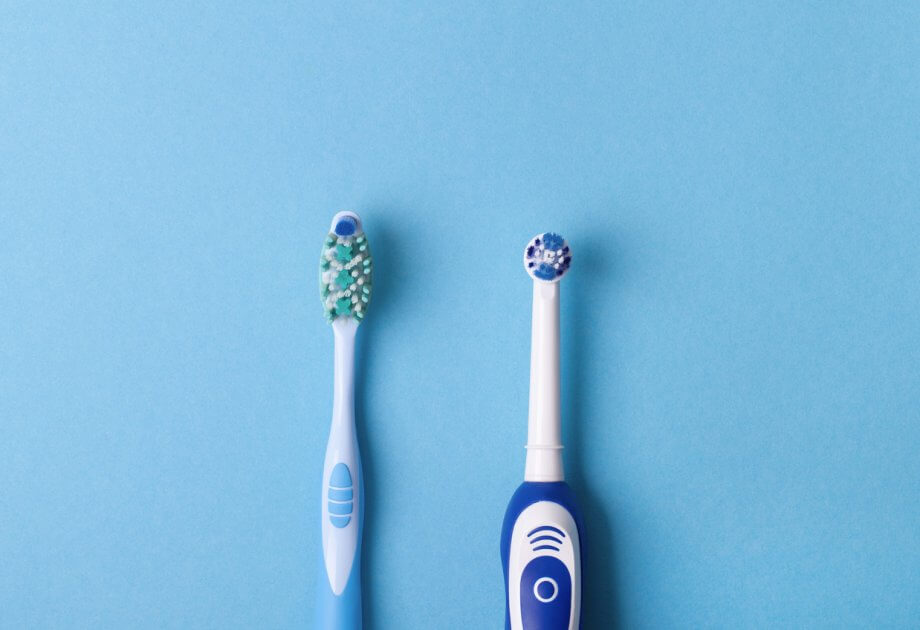It might seem like an inconsequential decision, but choosing the right kind of toothbrush is actually more important than most people think. With the wrong type of brush, you can cause your gums to recede, leave plaque buildup on your teeth, or erode away the enamel and cause stains.
The best way to know which toothbrush is right for you is to talk to us at your next oral exam appointment. You may have special needs that can be addressed with a specific type of brush. What follows are recommendations for patients who have healthy teeth and gums, with no oral health concerns.
Buying a Manual Toothbrush
A manual toothbrush (also known as a disposable toothbrush) is the old-fashioned kind that’s powered by you and not a battery. When it comes to buying a manual toothbrush, people usually fall into one of two categories: they either grab whatever is cheapest or they stare at the seemingly infinite possibilities in the oral care aisle and agonize over which one is best. You don’t need to stress about which brush to choose, but you should put at least some thought into it. Here’s what to consider when making your decision:
Look for the ADA Seal
Not all toothbrushes are approved by the American Dental Association. If you’re shopping at a dollar store or even for eco-friendly toothbrushes made with bamboo or charcoal-infused bristles, your brush might not be ADA approved. Look for the ADA seal on the packaging and if you don’t see it, don’t buy it.
When you see the ADA seal, you can feel confident knowing that the toothbrush is safe, effective, and meets the American Dental Association’s high standards. Cheap brushes imported from abroad may have bristles that fall out, wear out quickly, or even damage your tooth enamel. ADA-approved toothbrushes have bristles with rounded tips that don’t cause damage or scratches and that won’t fall out easily, and a handle that won’t snap in half while you’re brushing.
Buy the Right Size
This can be a little tricky to judge since toothbrushes are sold in packages and you can’t exactly test one out in your hand before making your purchase. A brush needs to have a sufficiently long handle so it can be held comfortably and it can reach all the way to the back of the mouth. The brush head should not be so big that it makes it difficult to maneuver and clean all those hard-to-brush areas—one-inch tall and a half-inch wide is about the maximum size for a brush head.
Skip the Hard Bristles
Some patients don’t know that hard bristles are bad news for teeth and gums. Others know that hard bristles aren’t recommended, but they can’t stop themselves from buying these brushes anyway—they swear they’re the only way they can get their teeth clean and that soft bristles leave their teeth feeling full of plaque.
Unless your dentist tells you otherwise, there’s no reason to buy hard-bristled toothbrushes. Even medium-bristled toothbrushes aren’t really needed. Stick with soft bristles. As long as you use proper brushing technique, they’ll get your teeth just as clean as the harder bristles.
When you purchase toothbrushes with hard bristles—and especially when you brush with a lot of pressure, which many people do—you put your gums at risk. Over time, your gums may begin to recede. Although the type of gum recession caused by brushing with hard bristles isn’t as dramatic as that of gum disease, it can expose the root surface of your teeth and cause painful tooth sensitivity.
Hard bristles also damage the tooth enamel, particularly when you brush hard too. Tooth enamel protects teeth from cavities, so when your enamel is worn away, it makes it easier for bacteria and decay to attack your teeth. Worn off enamel is also a contributing factor to stains because without its protective barrier, tea, coffee, red wine, and other foods and drinks that stain can more easily penetrate the teeth.
Other bristle advice: multi-level or angled bristles perform better than flat-bristles when it comes to removing plaque, but no matter which type of bristles you end up choosing, none of them perform well when they’re worn out and frayed. Replace your brush every three to four months!
Buying an Electric Toothbrush
Electric toothbrushes are fantastic for your teeth and, generally speaking, they do a better job than manual toothbrushes. That’s not to say that manual brushes don’t work well too; it’s just that electric toothbrushes make the job easier. They’re better able to loosen plaque from the surfaces of your teeth and with their built-in timers, you’ll be able to ensure that you’re brushing the recommended two minutes.
Just like with manual toothbrushes, it’s important to look for the ADA seal of acceptance to make sure the product you’re buying is safe, dependable, and effective. Electric toothbrushes go through even more rigorous testing than manual toothbrushes in order to earn a seal from the American Dental Association. They are sent to an independent laboratory for safety testing and manufacturers are required to prove that the brush is safe for use on the teeth and soft tissues of the mouth through clinical trials.
Here are some things to consider when buying an electric toothbrush:
Cost
Electric toothbrushes vary greatly in terms of price. There are battery-operated ones that are only a few dollars more than manual toothbrushes and rechargeable models that cost hundreds of dollars. The good news is that you don’t have to break the bank to get a decent electric toothbrush. In general, even the most inexpensive electric brush is better than a manual brush in terms of loosening plaque from tooth surfaces.
When evaluating cost, don’t forget to check the price of replacement brush heads for the model you’re considering. (If you’re prone to forgetting when it’s time to switch to a new toothbrush, you might want to buy a brush with a subscription service for brush head replacements.)
Features
The most basic type of electric toothbrush simply turns on and off. If you have room in your budget to upgrade, there’s a whole host of options available. Here are some features to look for:
- Different modes for sensitive teeth, gum care, whitening, tongue cleaning, etc.
- A built-in timer so you know when you’ve brushed for two minutes
- A travel case to make it easy to bring your brush with you
- An app to track your brushing
- A sensor that alerts you when you’re using too much pressure
- Built-in toothbrush sanitizers to kill bacteria
Type of Movement
There are different types of electric brushes that move in different ways. A side-by-side moving brush is the most basic type of electric toothbrush and the kind that’s most affordable. As its name suggests, the bristles move from side to side rather than oscillating or vibrating.
Other types of electric toothbrushes include counter oscillation, rotation oscillation, circular, and ultrasonic. Rotation oscillation brushes have been shown in clinical trials to remove more plaque than manual toothbrushes. They can be as fast as 8000 strokes per minute, allowing you to brush thoroughly with a minimal amount of pressure.
Bristles
Just like with a manual brush, electric toothbrushes have brush heads with different types of bristles. Always choose soft bristles. In fact, if you have a manual toothbrush with soft bristles now and you feel like it’s not doing a good job removing plaque from your teeth, try switching to an electric toothbrush with soft bristles—you’ll be pleasantly surprised by what a difference it makes.
Other brush head options include bristles for whitening, gum care, sensitive teeth, plaque buildup, orthodontia, and more. As long as the brush head you choose has soft bristles, feel free to choose any replacement brush head that fits your needs.
Best Toothbrushes for Children
The guidelines for buying a toothbrush for children are much the same as buying for adults. First, always make sure you buy a toothbrush with the American Dental Association seal of approval to ensure that it’s safe and effective. Children, like adults, should use brushes with soft bristles and, because children’s mouths are smaller, the brush head should be smaller too.
Children can also benefit from using electric toothbrushes. Many kids have trouble brushing for two minutes, so the built-in timer can be a helpful reminder to them—it can even make brushing more fun.
Why It Matters
When you brush well at home, it means you’ll spend less time at the dentist’s office. While we’re always happy to see you, we have a feeling you’d probably prefer a short dental cleaning every six months rather than having to come in frequently for dental work. Brushing is important, but brushing with the right tools also matters.
Schedule an Appointment
If you have questions about which type of toothbrush is right for you, feel free to ask your dentist or hygienist at your next appointment. We’re always happy to make toothbrush and toothpaste recommendations. To schedule an appointment at Smiles on the Upper Westside, contact us today at 212-222-5225.

